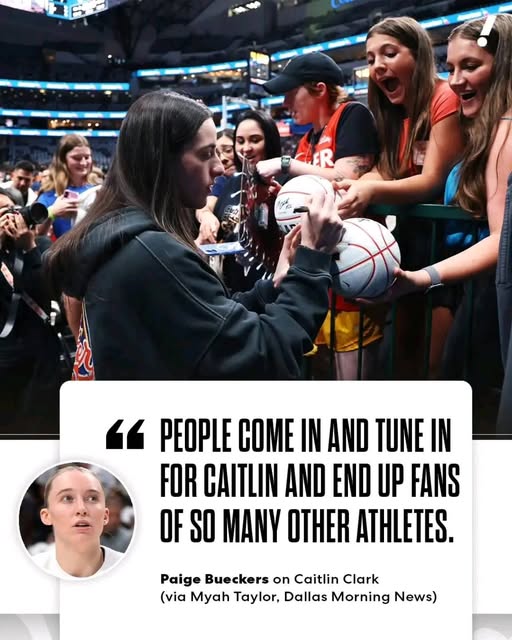Paige Bueckers, the dynamic guard from UConn and trailblazing star of women’s college basketball, recently took a moment to shine a spotlight on one of her emerging counterparts in the game—Caitlin Clark. In a heartfelt and public acknowledgment, Bueckers honored Clark for her efforts in elevating the profile of other WNBA players and her broader contributions to the sport. Her gesture was both sincere and meaningful, a testament to the growing camaraderie and shared mission among basketball’s brightest rising talents.
Basketball—particularly women’s basketball—is in the midst of a renaissance. Viewership numbers are climbing, discussions are flourishing, and the athleticism and personalities of the players are capturing hearts and headlines in ways never seen before. If you scroll through social media, tweet threads, or lively conversations around campfires and coffee, one name almost always comes up: Caitlin Clark. She’s become an icon in her own right—an athlete who not only excels on the court but whose unbridled energy, clutch shot-making ability, and magnetic charisma have sparked renewed interest in women’s hoops.
But with such attention invariably comes scrutiny, and occasionally criticism. In the spotlight, every pass, every shot, every off-court expression is dissected. Some of the discourse around Clark has veered into the negative—questioning her, scrutinizing every gesture, waving the “too much hype” flag. That’s why Bueckers’s public support holds weight: she’s not just celebrating Clark’s athletic prowess, but embracing the idea that an individual can use stardom to amplify others.
The phrase “giving her flowers” is lyrical—but it’s also powerful in this context. It means acknowledging Clark’s courage, acknowledging her commitments beyond scoring stats, acknowledging the ripple effect she’s having across the league. Bueckers’s tremelo of praise came during a post-game interview (the precise phrasing was off the cuff, casual and real), in which she remarked, “Caitlin’s doing something special. She’s got that spotlight — and she’s shining it on other WNBA players, too. That’s rare. That’s real.” Those words landed across platforms, quickly amplified and embraced by fans and players alike.
What makes this lending of applause particularly compelling is the dynamic between the two. Paige Bueckers is a decorated athlete in her own right. She’s battled injuries, celebrated comebacks, driven UConn to prominence, and shown grit in moments when few thought she could—or would—bounce back. That lens of challenge and triumph gives her perspective. She knows the work, she recognizes resilience, and she understands how tough the road is for athletes in women’s basketball. When such a voice labels someone else an ally to the cause, that carries credibility.
Meanwhile, Caitlin Clark is stirring both admiration and debate—on the court and in headlines. Her courtship with hype is unmistakable, but she’s been perceptive enough to channel it. More than just a dynamic playmaker, she’s hosting young, up‑and‑coming players postgame, lending a microphone, praising moves and assists, calling out lesser-known pros in an act of communal lift. It’s not just visibility for herself—it’s a conduit for elevating others. She’s spotlighting overseas players, bench units, athletes who have bustled for yardage in the travel circuit and deserve airtime. It amounts to the sort of advocacy Bueckers highlighted.
A standout example came weeks ago, when Clark responded to a question in a press conference by saying, “Look at what [Player X] did—did you see that hustle? That matters.” It was more than a statement. It was an assertion: “I’m paying attention to more than just my stat line. I’m paying attention to the league.” Another moment played out on X (formerly Twitter), in which Clark reposted a highlight video of a rising rookie’s block and followed it up with a public “This is next-level stuff—keep it coming!” simple, yet supportive. These moments reverberate. They shift narratives.
Caitlin’s approach parallels a broader awakening in women’s sports—celebrating collective uplift over individual golden sunbursts. It echoes in trends like players in the WNBA tweeting praise for overseas leagues, or promoting youth clinics in underserved communities. And it signals a recalibration: stardom no longer demands solitude. Instead, it’s about generational building, ensuring next-tier talents enjoy the stage, the narrative, the appreciation.
Paige Bueckers, tasked with leading Connecticut’s charge this season, knows the burden and the opportunity. She’s carried the mantle of college basketball’s most followed guard, with models, press, and rebuilding seasons shaping her storyline. Yet in acknowledging Clark’s contributions, Bueckers underlines a fundamental truth: the strength of the sport lies not in one superstar, but in its constellation of voices rising together.
Her public praise does more than validate Clark—it validates the entire movement. It says: spotlighting others is leadership. It says: when one shines, we all shine. The sport gains momentum, sponsors lean in, media coverage broadens—and barriers begin to crumble. Not to mention recruiting pipelines flourish, with each generation of athletes seeing not just an established star, but a community of peers giving each other grace, visibility, and applause.
It’s sometimes easy to focus on rivalries, on narratives like “Player A vs. Player B,” or on the anticipation of the next viral tweet or buzzer‑beater. But the reality is richer. There’s an emerging undercurrent—an ethos—rooted in shared ambition and community empowerment. And Clark is tapping into that, using her platform to spotlight others, big and small. Her words magnify benches, overseas brims, and fresh faces. And Bueckers sees the merit, voicing her admiration publicly.
In the landscape of women’s basketball, seasons and careers flip faster than you can tally trades or transfers. Injuries, adversity, recruiting cycles—they’re part of the roller‑coaster. But moments like this—public recognition from a peer—cut deeper. They forge relationships, they spark movements, they cement a foundation. With Bueckers delivering praise, she opens the door for other stars to follow suit. Imagine Breanna Stewart, A’ja Wilson, Sabrina Ionescu, all affirming Clark’s doing good. That chorus would resound.
Beyond emotional resonance, there are practical ripples. Sponsors take note. Media gears pivot toward the broader tapestry. Networks ask more compelling questions. And kids watching gain richer perspective—not just “who’s the best scorer,” but “who’s building ladders for others.” That narrative shift is pivotal. Because today’s conversation shapes tomorrow’s culture—and identity.
Looking ahead, what might emerge from this recognition? There are a few tangible possibilities:Other top-tier athletes may begin organizing showcase games, virtual events, or guest appearances, all aimed at highlighting lesser-known pros.Imagine postgame pressers where star athletes, like Clark, spontaneously ask about teammates’ performance, weaving in praise naturally. That sets a tone.Media outlets often chase the headlines—but elevated interest in underground talents could broaden coverage, prompting deeper, more diverse storytelling.Brands focusing sponsorship not just on marquee names, but packaging campaigns that celebrate collective impact. Products, events, philanthropy built around community uplift.
But none of this starts without seeds of recognition. Bueckers, via her spotlight, planted one.
It’s also important to note that “giving flowers” goes both ways. While Bueckers offered acclaim, Clark echoed appreciation in turn—highlighting how growing attention brings with it responsibility. In interviews, she’s taken time to amplify teams, sketched out player-of-the-game shoutouts, and engaged with youth programs alongside pros outside her orbit. Her words: “Our game is bigger than any one court or one season. It’s built of many players, many paths, many stories.” That’s the kind of mindset athletes need to thrive together—not just as competitors, but as comrades.
That leadership exists in tension with competition. The WNBA is a battleground; playoff pushes are no place for halfheartedness. But recognizing excellence in others doesn’t weaken the competitive fire—it inflames it. Players become more determined to outwork each other, but also to individually lift up the sport. It’s competitive kindness: strive for yourself, lift for the rest.
Paige Bueckers’s acknowledgment echoes beyond that tweet or interview clip. It’s symbolic of what’s at stake. NCAA stars transition into WNBA pros, casual watchers become dedicated fans, and small-market athletes snag attention once reserved for the usual media magnets. That network of recognition strengthens the entire ecosystem, from gate receipts to broadcast deals to grassroots programming.
If one thinks of this moment as a pebble tossed into a pond, the ripples expand beyond the immediate scene. Young players watching think, “If Caitlin can—for me, for us—maybe I should do the same.” Media producers reframe story arcs to highlight collaborative dynamics. Coaches integrate peer-appreciation into team culture as a form of cohesion. Longtime WNBA supporters experience renewed validation—that the league’s trajectory is now co-authored by fresh voices.
Ultimately, this interaction—older peer lifts younger, spotlight passed along like an honor baton—is emblematic of sports at their best. It’s reminiscent of earlier eras, where elder statespeople nurtured successors, where gatekeepers used access to broaden horizons. Now modern athletes, armed with social media tools and amplified platforms, can democratize access in real time.
In this way, Paige Bueckers giving flowers to Caitlin Clark is more than a compliment. It’s a nod to vision—an embrace of shared opportunity. And it leaves a blueprint: yes, chase greatness. Yes, build legacy. But don’t forget to build each other up along the way. That’s what transforms a game into a movement—and what ensures that when the final whistle blows, what’s left is not just statistics, but a thriving, inclusive, sustained community.
In time, the narrative will be richer: “Remember when Clark turned the spotlight on others?” And “Bueckers recognized that strength.” That’s how legacies grow—united, not divided; communal, not individual. That’s how championships gain meaning. In this evolving era of women’s basketball, where attention spans are shorter yet stakes higher, it’s these gestures of mutual recognition—giving flowers—that matter most. They signal: success isn’t measured only by points or gowns, but by who you lift with you.
Here’s to those flowers. May they continue blooming across courts, across cameras, across communities.



